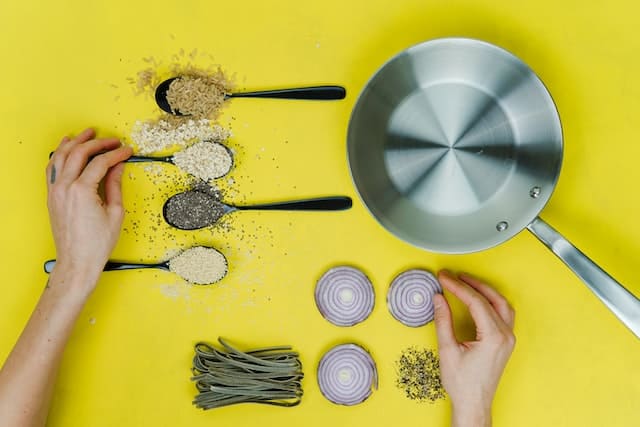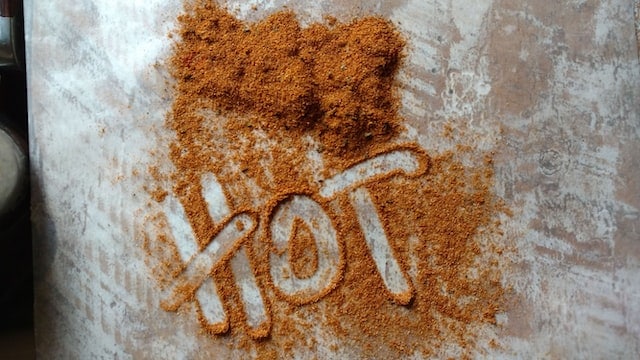You can’t concentrate on your work. You keep feeling the warmth of a spicy lunch on your palms. And you keep checking if it’s alright. And every time you get distracted, you try to rub your hands clean with napkins. But when you look at your palms again, the fire still burns. This spice needs to stop!
There are many ways to remove spice from your hands. And the answer is in this blog. So keep reading and let’s start!
What Makes Spices Burn Hands?

If you’ve ever burned your hands on a hot spice, you’re not alone. It can happen to anyone.
The truth is that there are lots of different kinds of spices and they all have their own unique chemical properties. The way those properties react with your skin is what makes some spices burn when they come in contact with it.
For example, the chemical compounds in chili peppers work by stimulating pain receptors in your mouth and throat. Those same compounds also activate nerve endings in your hands, which causes them to feel hot. That’s why chili peppers can burn both your tongue and your hands!
Capsaicin works by stimulating the pain receptors on your skin, which causes them to respond by sending signals to your brain that are interpreted as “hot” or “painful.” While this may seem counterintuitive, it actually makes sense because most of us associate heat with pain, think if someone burns themselves on something hot enough! The burning sensation caused by capsaicin helps our brains recognize when we are coming into contact with something very hot so we can avoid further injury or damage from burns or scalding water from hot pots or pans.
List of Spices That Can Burn Hands

Burn is one of the most common injuries in the kitchen. But did you know that you can still have burns even when you didn’t touch any hot surfaces? Yes! And this can occur when you touch or hold some spices in your hands! So here are the most common spices that can literally burn your hands:
🟥 Black pepper
Black pepper is very common as a spice because of its flavor and kick. But if you grind it and hold it for a longer period, expect your hands to get slightly burned. Aside from this, it can give off an overpowering scent that can trigger your allergies.
🟥 Paprika
Another common kitchen spice is paprika. It is a product of dried peppers usually found in Mexican, Spanish, and Hungarian foods. This spice is also used as a condiment for veggies and meat dishes.
Paprika has a special content that is responsible for its burning effect. This content is called “papain” which is also responsible for breaking down the protein in your stomach. But even though it can burn your hands, paprika is great for your eye health. It has carotenoids, that make it red in color, which can help fight free radicals that affect the eye, such as cataracts and macular degeneration.
🟥 Cayenne pepper
If you don’t want to burn your hands, avoid getting in contact with cayenne pepper. The hotness of cayenne peppers depends on the level of their dryness and the process of powdering them. If you have tried Tabasco sauce, then you now have an idea of how spicy cayenne peppers are because that’s the main ingredient of the sauce!
🟥 Chilies
Chilies contain capsaicin which creates a burning sensation when in contact with the skin. This can irritate not only your skin but also some sensitive areas, like your eyes and lips. That is why you need to be careful when wiping your face after eating any kind of chilies because they can really hurt a lot.
🟥 Garlic
Everyone knows garlic. But only a few of us are aware that it can burn our hands! This case is especially for those who have sensitive skin or those that have minor cuts on their hands. But, it is still one of the most affordable spices and we love to use it in our cooking!
🟥 Turmeric
Turmeric is a yellow spice that can stain your hands when touched. This stain is caused by curcumin which is responsible for its bright yellow color. But aside from staining, turmeric can also slightly burn your hands! So make the stain the sign to wash your hands!
Step-by-Step Guide To Remove Spice From Hands
A spice is a common ingredient that is used to add flavor and kick to any dish. But one problem that you may experience is irritation when it touches your hands. And if you do not address it as soon as possible, expect a burning sensation all over your palms. So here is the step-by-step guide on how to remove spice from your hands:
Step 1: Wash your hands
Of course, the first thing you need to do is to wash your hands. This is to remove the visible traces of spice in your palms and nearby spots. Use mild soap and warm water then rub your hands until you feel that the spice is gone. Just remember not to rub your palms too much, as the heat from the friction can enhance the effect of spice.
Step 2: Mild soap
As mentioned in the first step, it’s important to use mild soap. You can use an antibacterial soap to remove the bacteria and microbes present in your skin. This will also help your hands heal faster, especially if there are already burns on your palms. Remember to use warm water also as this will neutralize the spice on your hands.
Step 3: Cold water
After washing your hands with warm water and mild soap, you need to soak your hands in cold water. This will cool down the burns (if there are any) and reduce inflammation. Then, observe your hands, and if you think there’s still spice on your hands, repeat the previous steps.
Step 4: Moisturize
After removing the spice from your hands, dry your hands completely. Then, apply moisturizer or natural oils like olive oil to break down residual spices.
Tips To Prevent Spices From Burning Your Hands
Tip 1: Protect Your Hands
If you know that your hands are sensitive or allergic to some spices, protect your hands at all costs. You can use oven mitts or gloves that are made of leather and cotton. These will insulate your hands to prevent the spices from burning your hands. And take note that you don’t need to buy expensive pair! As long as your hands are not in contact with spices directly, you’re good to go!
Tip 2: Don’t touch your eyes
Aside from protecting your hands, you also need to avoid touching your eyes. This is because spices sting so much and your tears will not do anything to subside the inflammation and pain! If your eyes are itchy, you can use a towel or soft fabric. Because remember, always hands off your eyes!
Tip 3: Practice washing
Though it will be a hassle to wash your hands after every contact with spices, it’s an important step that you must practice. This will prevent the spice from lingering on your skin and will be easier to solve the burning problem in case there’s one.
Tip 4: Do not rub your hands
Your hands are already burning, or if they are not, they can start burning. Rubbing can cause friction and friction can release heat. The heat from rubbing plus the heat from the spice can double up the level of burn your hands may experience.
Bonus: How To Treat Mouth Burn Caused By Spices

If you’ve ever eaten something spicy, there’s a good chance that you’ve experienced the burn of hot peppers in your mouth. Whether it’s from a Mexican dish or Indian curry, spices can leave your tongue and mouth feeling like they’re on fire. Luckily, there are ways to get rid of this painful sensation quickly so that you can enjoy the rest of whatever meal you’re eating, or at least avoid looking like an idiot while trying to deal with it!
🟥 Remove the spice from your mouth.
The most basic solution is to simply spit the spice out of your mouth. If you’re able to, use water to wash away any remaining residue on your tongue, but be careful not to swallow any water if you have an open wound in your mouth (which can happen when eating very spicy food). But if this isn’t possible and you need to get back to work right away, try using a paper towel or napkin to wipe off as much of the spice as possible before continuing with whatever else it was that brought you out of the kitchen in the first place.
If all else fails and nothing else seems effective, apply ice cubes directly onto your tongue; they’ll numb it enough that even though they won’t eliminate all pain entirely (they will help), they will at least reduce discomfort until other methods become available.
🟥 Rinse with water.
If you can, use warm water. If you can’t, use cold water instead. Don’t use hot or ice water, and definitely don’t use carbonated water or saltwater.
You may have noticed that most of the foods and beverages you eat are either cold or room temperature. This is because the human body prefers these temperatures for digestion purposes. And when we eat something hot, it’s almost always an accident (for example: accidentally leaving your coffee cup on top of a heating element). So if you’re going to be drinking something that’s not meant to be drunk at all, like coffee or tea, you should probably sip it slowly until it cools down enough so that you won’t burn yourself by accident!
🟥 Eat something sweet to help with the burn.
If you’ve burned your mouth with spicy food, it may be because of the capsaicin in that food. Capsaicin is the chemical that causes the burn and is found in peppers like jalapeño and cayenne. When you eat something hot and spicy, it can create a burning sensation on your tongue and lips. You can reduce the pain by eating something sweet to help neutralize the burn or reduce swelling in those areas.
Eating sugar also helps with pain relief since sugars are ingested quickly into your bloodstream and act as an energy source for cells throughout your body including nerves which send signals from your brain to muscles telling them how to move. Sugar also helps mask taste buds so you don’t notice as much bitterness from spicy foods (like habanero peppers).
🟥 Drink milk or try milk of magnesia.
Milk of magnesia is an antacid that can be found in drug stores. Antacids help neutralize stomach acid, which can make you feel better if you have heartburn or indigestion. They also assist with the production of saliva, so they’re good for both dry mouth and general discomfort caused by spice burns in the mouth.
If you don’t have the milk of magnesia on hand, try drinking a glass or two of milk or water with lemon juice squeezed into it. You may need to drink several glasses within a short amount of time to get any relief from your symptoms though!
🟥 Use a commercial mouthwash.
If you have a mild burn, try using an over-the-counter mouthwash. Listerine is commonly recommended, but there are other options as well. If your burn is more severe or you don’t have any commercial mouthwashes available, consider brewing some tea for yourself instead!
Final Words
In conclusion, removing spice from hands can be a tricky task, but with the right methods and tools, it can be easily done. Just remember to always be careful when handling spices and to wash your hands thoroughly after handling them to avoid any potential irritations or reactions. It’s also important to keep in mind that some spices can cause skin irritation or allergic reactions. If you find that your hands are red, itchy, or swollen after handling spices, it’s best to seek medical attention.
If you want to grind your spices, you can click here to know which tool is the best!
